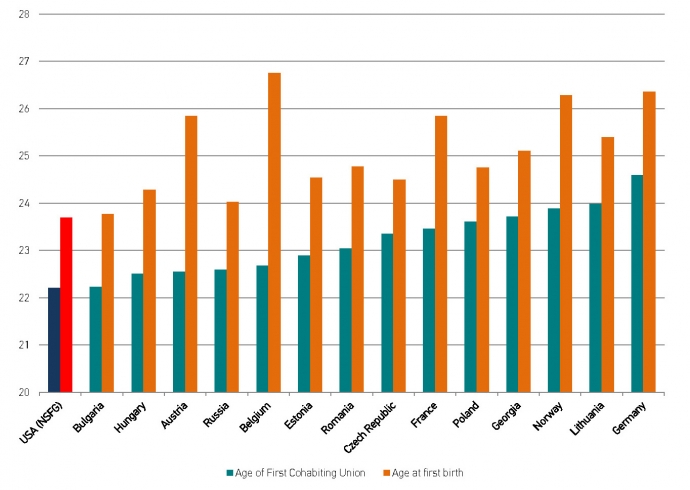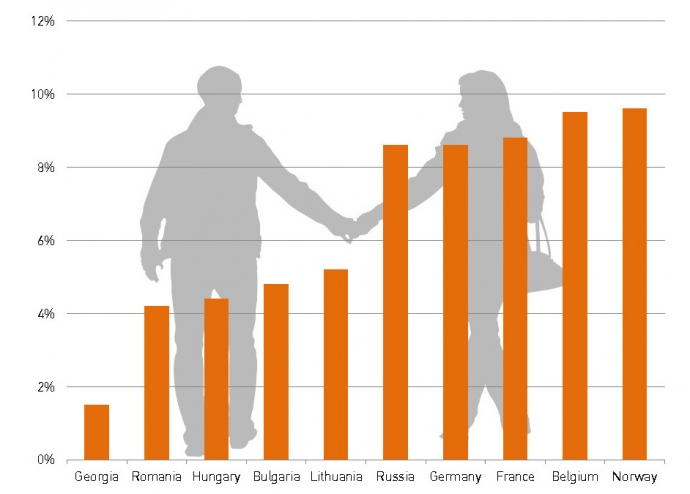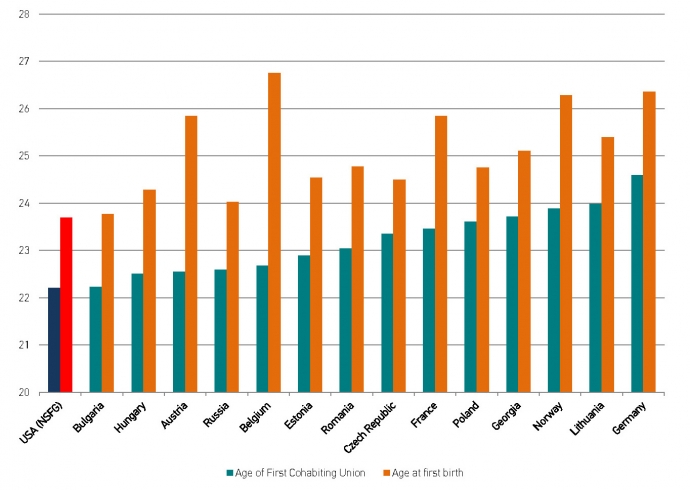The GGP has recently intergrated the Harmonized Histories Dataset within the GGP Data Collection and it is now available to all users The Harmonized Histories are a simplified dataset that covers partnership and fertility histories as well as some primary indicators. The dataset also includes data from the United States through the National Survey for Family Growth and we hope to add data from other countries in the near future. The dataset has been specifically adapted for use in event-history analysis and is therefore ideal for analysing the retrospective history elements of the GGP. It is aslo ideal for teaching event-history analysis as it is a smaller and simpler dataset than the full GGP dataset. The dataset was developed by the Non-Marital Childbearing Network and colleagues at Max-Planck and the GGP will continue to work with them to further develop this useful addition to the GGP data collection.
Age of First Cohabiting Union and First Birth

Source: Perelli-Harris, Brienna, Michaela Kreyenfeld, and Karolin Kubisch. Harmonized histories: manual for the preparation of comparative fertility and union histories. No. WP-2010-011. Max Planck Institute for Demographic Research, Rostock, Germany, 2010.
The GGP has recently intergrated the Harmonized Histories Dataset within the GGP Data Collection and it is now available to all users The Harmonized Histories are a simplified dataset that covers partnership and fertility histories as well as some primary indicators. The dataset also includes data from the United States through the National Survey for Family Growth and we hope to add data from other countries in the near future. The dataset has been specifically adapted for use in event-history analysis and is therefore ideal for analysing the retrospective history elements of the GGP. It is aslo ideal for teaching event-history analysis as it is a smaller and simpler dataset than the full GGP dataset. The dataset was developed by the Non-Marital Childbearing Network and colleagues at Max-Planck and the GGP will continue to work with them to further develop this useful addition to the GGP data collection.
Age of First Cohabiting Union and First Birth

Source: Perelli-Harris, Brienna, Michaela Kreyenfeld, and Karolin Kubisch. Harmonized histories: manual for the preparation of comparative fertility and union histories. No. WP-2010-011. Max Planck Institute for Demographic Research, Rostock, Germany, 2010.
Living apart together (LAT) relationships are when a couple are in a relationship but choose not to live together. They are an interesting topic of study because data on these relationships is hard to come by as they do not appear in residency or marital registries. Surveys like the Generations and Gender Survey (GGS) are therefore vital in studying how prevelant these types of relationships are, what type of people generally have them and whether they are similar to marriage and cohabitation. Indeed, data from the GGS has been used by several international research projects which have examined precisely these questions. The findings suggest that such relationships are in fact a sizeable minority and often allow couples to meet short term work and educational requirements. They are therefore most common amongst the highly educated and those who are still in education. LAT relationships at older ages are most common amongst those who have experienced divorce in a previous relationship and those wanting to maintain independence.
Percentage of Adults living in LAT relationships by Country

Source: The graphic contains data from Wave 1 of the Generations and Gender Survey and the following publication: Liefbroer, Aart C., Anne-Rigt Poortman, and Judith Seltzer. “Why do intimate partners live apart? Evidence on LAT relationships across Europe.” Demographic Research 32.8 (2015): 251-286.
Separation and divorce have large consequences for the well-being of family members and for intergenerational exchanges. In France, almost one in five children whose parents have separated or divorced never see their father. Children with separated or divorced fathers often do not live with them but nonetheless see them frequently at young ages. However, the frequency of contact rapidly dwindles afterwards so that the proportion who never see their father reaches 19% at ages 18-21 and 32% at ages 30-34. This contrasts strongly with contact with their mother. With a few rare exceptions, children with separated or divorced mothers report living with their mothers until they are 18. When they are older, contact between children and their mothers remains strong with only 5% of children aged 18-34 never seeing their mother. Age 18 is a clear break-off point, perhaps because rights associated with parental custody which apply until the children’s 18th birthday.
The contextual database for the Generations and Gender Programme contains over 100 macro indicators at the national and regional level. It draws on data from a number of sources and can be analysed either as a stand alone dataset or in conjunction with data from the Generations and Gender Survey. You can browse the data at ggp-i.org or you can choose to download the datafile itself in SPSS, STATA or CSV format (see page 3 for details). Data in the Contextual database streches back over four decades, enabling researchers to examine demographic change over time in Europe and beyond. Here we can see the dramatic change in fertility over the past 60 years and how the fall and subsequent recovery in fertility occured in different countries at different times. It is also possible to vizualise events that shaped Europe’s demography, such as the regime transitions of the early 1990’s. This data therefore adds a great deal of context to the rich individual level data within the Gender and Generations Survey and represents a useful research tool in understanding families and relationships at the macro level.
This month saw the release of wave 2 data for the Czech Republic, extending the number of countries for which have wave 2 data is available to nine. There are a further three countries (Italy, Austria and Russia) for which the data are currently being harmonised which will help extend this to twelve. Data from wave 2 allows researchers to examine one of the most compelling aspects of the Generations and Gender Programme which is the study of life plans and their realisation. Throughout the GGP questionnaire there are a number of questions relating to individuals intentions over the next 3 years and data from wave 2 helps researchers examine whether these plans are realised. Existing research from the GGP has suggested that there are considerable differences in realisation rates across countries, across socio-economic status and across gender. Data from countries like the Czech Republic therefore helps us expand this exciting and insiteful area of research.
Since wave 1, did you realise your intention to….

Fill the form below with your contact information to receive our monthly GGP at a glance newsletter.
